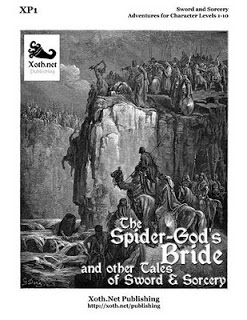As I quoted Tao of D&D in my previous post, “Function, then, is always incorporated into the world with an eye towards the desired behavior of the player”. Or in other words, the function of a setting is to encourage a certain style of play. I could just as well set my campaigns in Forgotten Realms or Dark Sun, but they are not quite what I want. And it isn’t even that I think certain elements of those settings are bad or just dumb, but neither quite captures the style I have in mind. A GM should not tell the players how they are supposed to play the game and how their characters should act. Giving the players only one option and denying them any kind of choice never makes the game fun for anyone. You can, however, place the PCs into situations in which the players will want to play in the way you intend. Because they conclude for themselves that this is the most effective and most fun way to deal with the situation. There should still be many options to take and choices to make, but if you prepare the game cleverly, most of these will match with the style you have in mind.
So the first question when adressing the subject of Function in the Ancient Lands would be, what style I do have in mind. My favorite examples of the kind of character interactions I would like tosee have long been Star Wars (movies), Mass Effect, Knights of the Old Republic (game and comics), and Ghost in the Shell, as well as Alien, Blade Runner, The Thing, The Witcher (games), Princess Mononoke, Yojimbo, and Conan the Barbarian. And you probably immediately notice something interestingly, which is that most of these are science fiction, with only two real examples of Fantasy among them. But that doesn’t have to be a bad thing. Should the AncientLands be a science fiction setting instead? Well, that has been done before. People keep agonizing about original ideas, and here’s something moderately different pretty much happeningby accident. Setting a generic fantasy hero story in space worked out great for Star Wars, so why nottransport postmodern science fiction into the Bronze Age?
With this step out of the way, it now comes to identifying what behaviors of characters from these movies and games I want to see from players in my campaigns.
- Defeat enemies while minimizing the risk to yourself. Don’t try frontal assaults against enemies who greatly outnumber you.
- Play dirty and exploit every advantage you can get.
- Accept cooperating with despicable and untrustworthy people to deal with bigger problems.
- When things get too hot, cut your losses and run to fight another day.
- Take what you can get and resist getting too greedy and lose everything.
- Respect people who deserve it, but refuse to submit to those who abuse their position orrefuse to admit their failures and make way for someone more capable.
- Never trust the words of known villains.
- When faced with two bad choices, keep looking for a third option.
- When there really is no alternative, do the thing that has to be done, but nobody wants to do.
- You can’t change the world, but you can make a difference here and now.
- For everything you do, there will be consequences, and you will have to live with them, however things will turn out.
This is what I want to see. This is the kind of thinking I want the players to develop, and the kind of behavior I want them to follow. From here on, all development follows in light of the question “how do you get the players to see this as the right way to go?”. Not every little detail has to contribute directly to that goal. But whenever a new detail is added, be it a dungeon, a magic item, a special rule, a cultural custom, or some kind of organization, it always should be examined in regard to that question. If it doesn’t really make a difference but seems cool anyway, it can still pass. But considering that a setting can easily get overloaded with junk, that makes it harder to find the important parts for players and GMs reading the material, you should really stop and think a moment if it’s really worth bothering with. Even if you work purely for yourself and a single campaign, there is only so much time you’re going to put into it, and it’s rarely worth the effort to develop an elment the players are never going to see in any way.

